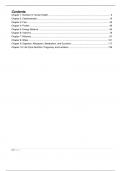Contents
Chapter 1: Nutrition in Human Health .................................................................................................. 2
Chapter 2: Carbohydrates ................................................................................................................. 19
Chapter 3: Fats ................................................................................................................................. 33
Chapter 4: Protein ............................................................................................................................. 49
Chapter 5: Energy Balance ............................................................................................................... 63
Chapter 6: Vitamins ........................................................................................................................... 76
Chapter 7: Minerals ........................................................................................................................... 87
Chapter 8: Water ............................................................................................................................. 101
Chapter 9: Digestion, Absorption, Metabolism, and Excretion.......................................................... 117
Chapter 10: Life Cycle Nutrition: Pregnancy and Lactation .............................................................. 129
1|Page
,Chapter 1: Nutrition in Human Health
1. Dietary guidelines are intended to:
1. Apply to the food intake for a single day
2. Apply to items to be ingested for one meal
3. Apply to people who are ill
4. Aid in preventing chronic and degenerative
diseases Ans: 4
Feedback
1. Dietary guidelines are intended to evaluate several days’ intake of food.
2. Dietary guidelines are intended to evaluate several days’ intake of food, not a
single meal or the intake for 1 day.
3. Dietary guidelines focus on healthy individuals aged 2 years and older.
4. Dietary guidelines, which focus on healthy individuals from age 2 years on,
are also aimed at those at risk for chronic disease to encourage proper dietary
habits to promote health and reduce the risk for major chronic diseases.
KEY: Integrated Process: Nursing Process | Client Need: Physiological Integrity:
Basic Care and Comfort | Cognitive Level: Comprehension
2. After reviewing the concept of nutrients, a nursing student demonstrates the
need for additional study if the student identifies which of the following as a
class of nutrients? 1. Alcohol
2. Carbohydrate
3. Fat
4. Protei
n Ans: 1
Feedback
1. Alcohol is not considered a nutrient.
2. Carbohydrates are one of the six classes of nutrients. Other classes include
fats, proteins, vitamins, minerals, and water.
3. Fat is one of the six classes of nutrients. Other classes include carbohydrates,
proteins, vitamins, minerals, and water.
4. Protein is one of the six classes of nutrients. Other classes include
carbohydrates, fats, vitamins, minerals, and water.
KEY: Integrated Process: Teaching/Learning | Client Need: Physiological Integrity: Basic
Care and Comfort | Cognitive Level: Analysis
2|Page
, 3. A chemical substance required by the body is called a(n):
1.
Additive 2.
Vitamin
3. Food
4. Phytochemic
al Ans: 2
Feedback
1. An additive, as the name implies, is a substance that is not normally
present but added to a food.
2. Vitamins are nutrients, which are chemical substances required by the
body.
3. Food is essential to life, but it is not considered a chemical substance.
4 A phytochemical is a physiologically active substance from a plant
source that can help promote health.
KEY: Integrated Process: Nursing Process | Client Need: Physiological Integrity:
Basic Care and Comfort | Cognitive Level: Knowledge
4. A substance found in food that must be present in the diet because the human body
lacks the ability to manufacture it in sufficient amounts for optimal health is called a(n):
1. Phytochemical
2. Essential
nutrient
3. Conditional nutrient
4. Nonessential
nutrient Ans: 2
Feedback
1. A phytochemical is a physiologically active substance from a plant
source that can help to promote health.
2. An essential nutrient is one that the human body requires but cannot
manufacture in sufficient amounts to meet the body’s needs.
3. A conditionally essential nutrient is one that, under most circumstances,
the healthy body can manufacture in sufficient quantities.
4. A nonessential nutrient is one that is not needed in the diet because the
body can make it from other substances.
KEY: Integrated Process: Nursing Process | Client Need: Physiological Integrity:
Basic Care and Comfort | Cognitive Level: Comprehension
3|Page
, 5. Which of the following statements by a client would indicate a need for
nutritional instruction?
1. “The six classes of nutrients are carbohydrates, fats, proteins, vitamins, minerals, and
water.”
2. “Nutrition can affect health positively or negatively.”
3. “Excessive intake of a nutrient can interfere with other
nutrients.” 4. “Milk is the perfect food containing all essential
nutrients.”
Ans: 4
Feedback
1. The six classes of nutrients are carbohydrates, fats, proteins,
vitamins,
minerals, and water.
2. Health is dependent on nutrition; the effect can be positive or
negative.
3. If a person ingests too much of one nutrient, other nutrients can
be
affected.
4. Milk is not the perfect food. It does not contain all of the essential
nutrients that a person needs.
KEY: Integrated Process: Teaching/Learning | Client Need: Physiological Integrity: Basic
Care and Comfort | Cognitive Level: Analysis
6. Metabolism is best described as:
1. The sum of all physical and chemical changes that take place in the body
2. A state of complete physical, mental, and social well-being
3. Chemical substances needed for growth, maintenance, and repair
4. The acceleration and deceleration of body
functions Ans: 1
Feedback
1. Metabolism is a term that refers to the sum of all physical and chemical
changes that take place in the body.
2. Health is a term that refers to a complete state of physical, mental, and
social well-being.
3. Nutrients are chemical substances supplied by food that the body needs
for growth, maintenance, and repair.
4. Metabolism does not refer to the acceleration and deceleration of body
functions.
4|Page




